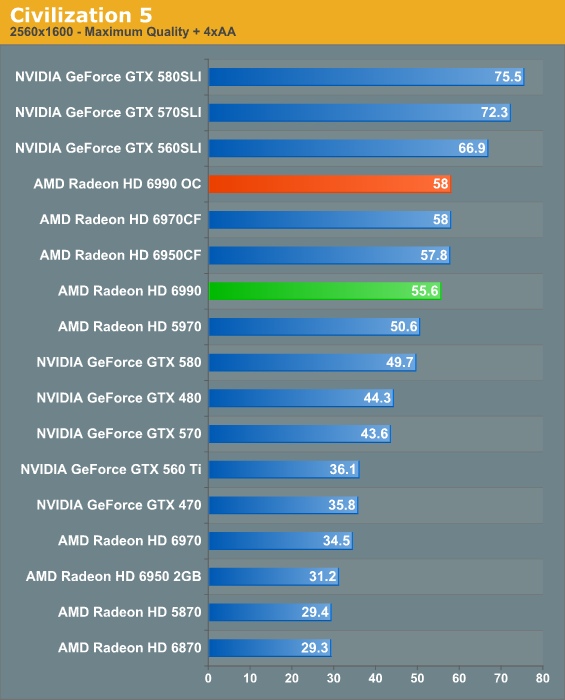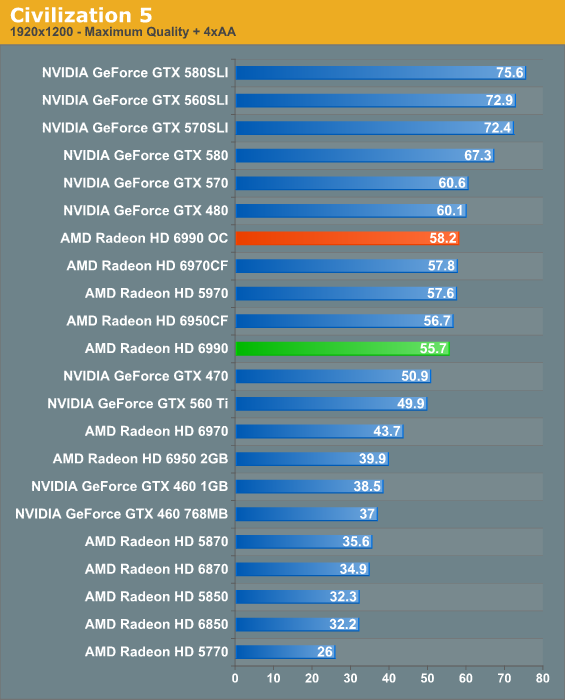AMD's Radeon HD 6990: The New Single Card King
by Ryan Smith on March 8, 2011 12:01 AM EST- Posted in
- AMD
- Radeon HD 6990
- GPUs
Civilization V
The other new game in our benchmark suite is Civilization 5, the latest incarnation in Firaxis Games’ series of turn-based strategy games. Civ 5 gives us an interesting look at things that not even RTSes can match, with a much weaker focus on shading in the game world, and a much greater focus on creating the geometry needed to bring such a world to life. In doing so it uses a slew of DirectX 11 technologies, including tessellation for said geometry and compute shaders for on-the-fly texture decompression.


In January we saw NVIDIA’s performance significantly improve in Civilization V. Since then AMD seems to have found their footing, albeit not as well as NVIDIA had. AMD’s primary gain here seems to be in CrossFire versus a boost in base performance, which works out well enough for the 6990’s launch. Interestingly Civ 5 is still so shader bound here on AMD’s cards that the 6990OC’s performance boost almost perfectly matches the increase in the core clockspeed. Still, at the end of the day the 6990 and the rest of the Radeons are still well outgunned by NVIDIA.










130 Comments
View All Comments
smookyolo - Tuesday, March 8, 2011 - link
My 470 still beats this at compute tasks. Hehehe.And damn, this card is noisy.
RussianSensation - Tuesday, March 8, 2011 - link
Not even close, unless you are talking about outdated distributed computing projects like Folding@Home code. Try any of the modern DC projects like Collatz Conjecture, MilkyWay@home, etc. and a single HD4850 will smoke a GTX580. This is because Fermi cards are limited to 1/8th of their double-precision performance.In other words, an HD6990 which has 5,100 Gflops of single-precision performance will have 1,275 Glops double precision performance (since AMD allows for 1/4th of its SP). In comparison, the GTX470 has 1,089 Gflops of SP performance which only translates into 136 Gflops in DP. Therefore, a single HD6990 is 9.4x faster in modern computational GPGPU tasks.
palladium - Tuesday, March 8, 2011 - link
Those are just theoretical performance numbers. Not all programs *even newer ones* can effectively extract ILP from AMD's VLIW4 architecture. Those that can will no doubt with faster; others that can't would be slower. As far as I'm aware lots of programs still prefer nV's scalar arch but that might change with time.MrSpadge - Tuesday, March 8, 2011 - link
Well.. if you can oly use 1 of 4 VLIW units in DP then you don't need any ILP. Just keep the threads in flight and it's almost like nVidias scalar architecture, just with everything else being different ;)MrS
IanCutress - Tuesday, March 8, 2011 - link
It all depends on the driver and compiler implementation, and the guy/gal coding it. If you code the same but the compilers are generations apart, then the compiler with the higher generation wins out. If you've had more experience with CUDA based OpenCL, then your NVIDIA OpenCL implementation will outperform your ATI Stream implementation. Pick your card for it's purpose. My homebrew stuff works great on NVIDIA, but I only code for NVIDIA - same thing for big league compute directions.stx53550 - Tuesday, March 15, 2011 - link
off yourself idiotm.amitava - Tuesday, March 8, 2011 - link
".....Cayman’s better power management, leading to a TDP of 37W"- is it honestly THAT good? :P
m.amitava - Tuesday, March 8, 2011 - link
oops...re-read...that was idle TDP !!MamiyaOtaru - Tuesday, March 8, 2011 - link
my old 7900gt used 48 at loadD:
Don't like the direction this is going. In GPUs it's hard to see any performance advances that don't come with equivalent increases in power usage, unlike what Core 2 was compared to Pentium4.
Shadowmaster625 - Tuesday, March 8, 2011 - link
Are you kidding? I have a 7900GTX I dont even use, because it fried my only spare large power supply. A 5670 is twice as fast and consumes next to nothing.